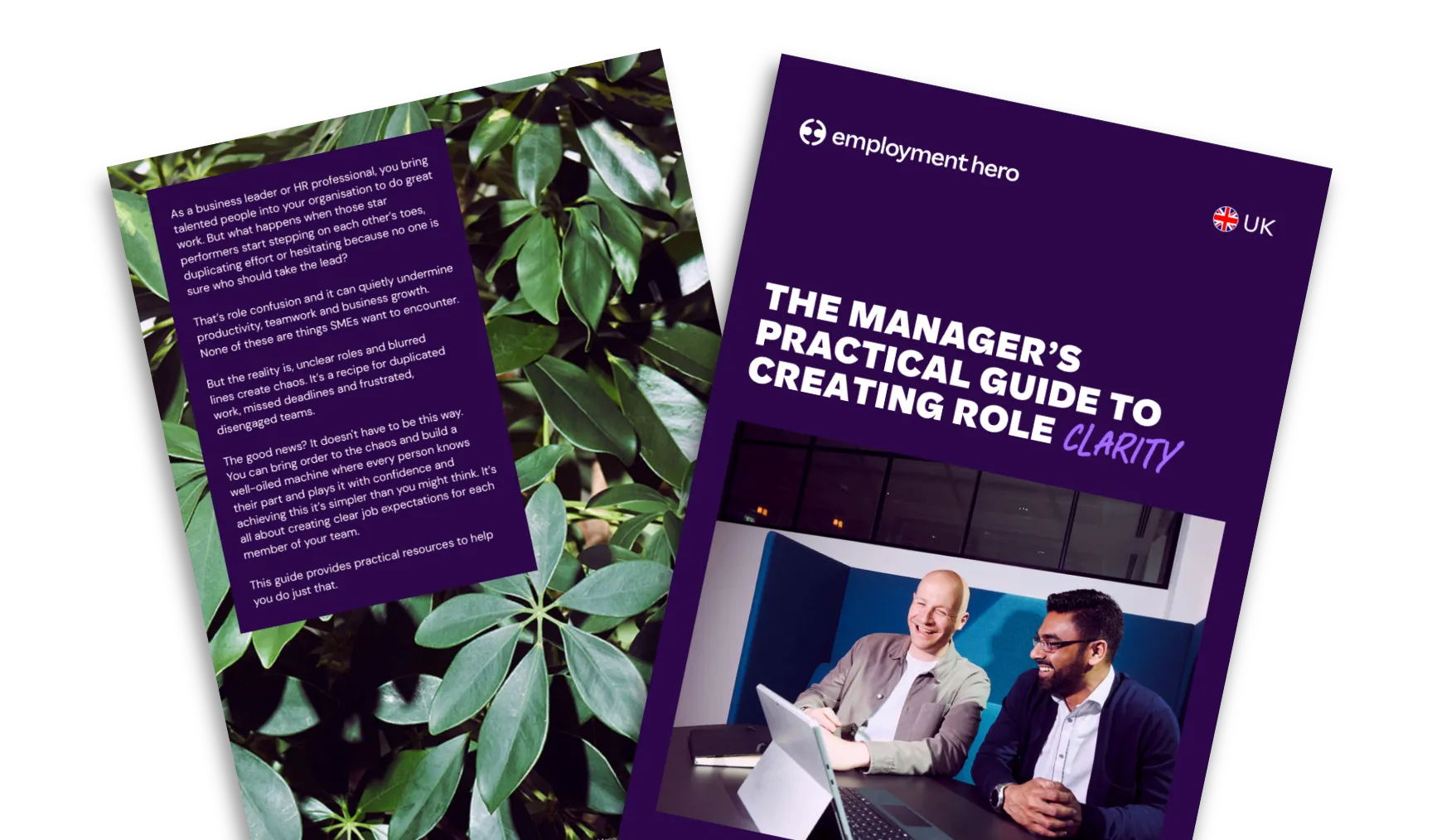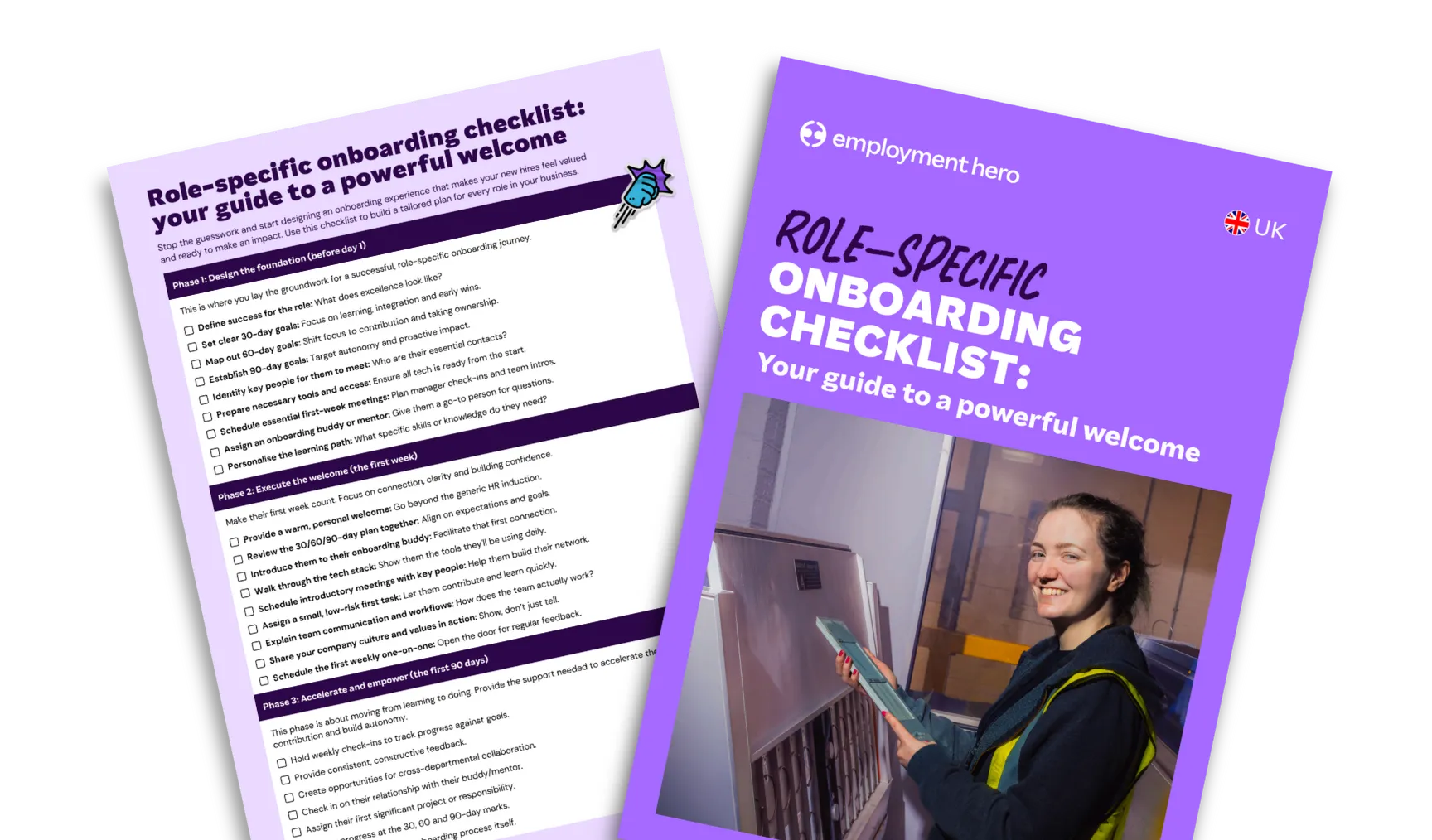Internal recruitment: strategies, best practices and checklist
Published
Internal recruitment: strategies, best practices and checklist
Published
1 min read
Internal recruitment checklist & policy template
With increasing competition for the best talent, businesses are starting to realise the benefits of tapping into their existing workforce to fill job vacancies. Why spend months searching outside when the perfect candidate might already be sitting two desks away? And already knows which meeting rooms actually have working HDMI cables. Internal recruitment strategies can empower your business to retain top performers, helping you save money and preventing you from having a high turnover.
This internal recruitment strategy checklist gives you a complete roadmap for building a promote-from-within culture. Here’s what’s included:
- 7 core strategy areas: From internal mobility to fair selection processes, with actionable guidance you can implement.
- Policy frameworks: Guidelines for internal job posting, employee mobility and diversity & inclusion policies.
- Expert tips: Practical advice on future leader groups, career tracks and reducing unconscious bias.
- Skills development: How to identify high-potential employees, assess gaps and design targeted programmes.
- Cross-department collaboration: Strategies for sharing talent and aligning hiring managers.
- Communication guidance: Best practices for job descriptions, applications and candidate feedback.
Whether you’re aiming to cut recruitment costs, boost retention, or just get more out of the people already on your payroll, this checklist helps shift internal recruitment from improvised to intentional. All of which can save you time, money, and the occasional awkward team meeting.
What is internal recruitment?
Like the name suggests, internal recruitment is the process of filling job roles and vacancies by considering existing employees in the business. Rather than sourcing brand new candidates outside of the business, it can involve promotions, transfers or structured succession planning.
External recruitment looks outward, such as advertising roles publicly or through agencies to attract fresh talent (and their inevitable “that’s not how we did it at my last company” observations). While external hiring often widens the talent pool and brings in new ideas, internal recruitment leverages employees who already understand the organisation’s culture, systems and values.
Both have their place in modern workplaces. Offering internal opportunities can help create a culture of career growth and progression, create more buy-in from your team and save you on some of the costs associated with hiring new employees. It can be a great way to improve morale and ensure that your team grows with the company.
Offering external candidates the opportunity is a good way to diversify talent, bring in specialised teams and grow your company size and capacity.
Common methods of internal recruitment
Employers typically rely on a mix of methods to recruit internally, each offering different advantages depending on the size, structure and culture of the organisation:
Promotions
Promotions involve elevating an existing employee to a more senior role.
- Best for: SMEs to large organisations with clear career progression pathways.
- Advantages: Boosts morale, rewards loyalty, reduces hiring costs and signals growth opportunities to employees.
- Be mindful of: Limited if the business lacks structured succession planning and unsuccessful promotion decisions may cause disengagement.
Transfers
Transfers move employees from one role or department to another at a similar level.
- Best for: Larger businesses with multiple departments or locations.
- Advantages: Helps fill gaps quickly, develops employee skillsets and can improve workforce flexibility.
- Be mindful of: Risk of skills mismatch if employees are moved without adequate support or training. Otherwise, you might end up with your star accountant running social media… which could be entertaining, but probably not effective.
Internal job posting
Job openings are advertised on internal platforms such as HR software, intranets or bulletin boards.
- Best for: Businesses of any size that want to encourage transparency and equal opportunity.
- Advantages: Ensures fairness by making roles visible to all staff, reduces bias and engages employees looking for new challenges.
- Be mindful of: Overexposure may cause disappointment if many employees apply and aren’t selected. Which can make for some very polite but very pointed smiles in the office kitchen.
Employee referrals
Current employees recommend colleagues or peers for open positions.
- Best for: Small and medium-sized businesses looking to build teams with cultural alignment.
- Advantages: Often leads to strong cultural fit, speeds up hiring and increases retention if employees feel accountable for their referral.
- Be mindful of: Risks of favouritism or reduced diversity if referrals dominate the hiring pipeline.
Talent pool or succession planning
Businesses identify high-potential employees and prepare them for future leadership or critical roles.
- Best for: Large organisations, or SMEs in industries where specialist skills are scarce.
- Advantages: Builds long-term resilience, reduces turnover risk and ensures leadership continuity.
- Be mindful of: Requires ongoing investment in training and development and may cause frustration among employees not selected for the pool.
What are the pros and cons of internal recruitment
Like any hiring strategy, internal recruitment comes with both advantages and drawbacks. While it can strengthen employee engagement, retention and cost-efficiency, it also has limitations that businesses should be aware of.
| Advantages | Explanation |
|---|---|
| Cost-effectiveness | Internal hiring reduces costs associated with external advertising, recruitment agencies and lengthy hiring processes. It allows organisations to allocate budgets more efficiently. |
| Faster onboarding | Existing employees are familiar with company systems, processes and culture. This knowledge reduces ramp-up time, enabling them to contribute effectively from day one. |
| Boosts employee morale | Promoting from within signals that growth is achievable, encouraging engagement and loyalty. Staff are more motivated when they see tangible career progression opportunities. |
| Reduces turnover risk | Employees who can see a clear path to advancement are less likely to leave for external offers. This helps organisations retain top talent and maintain workforce stability. |
| Disadvantages | Explanation |
|---|---|
| Limited talent pool | Restricting recruitment to current staff may limit access to new skills, perspectives and innovative ideas that external candidates could bring. |
| Risk of internal conflict or bias | Competition for internal roles can create friction among colleagues. Additionally, unconscious bias may influence hiring managers, potentially affecting fairness. |
| May discourage external innovation | Relying heavily on internal recruitment can lead to insular thinking and reduce the introduction of new ideas, best practices, or industry expertise from outside the organisation. |
Internal vs external recruitment: Which is right for you?
Internal recruitment focuses on drawing talent from current employees. It’s faster, reduces costs and promotes loyalty by offering growth opportunities. External recruitment, on the other hand, widens the candidate pool, bringing in fresh skills, ideas and perspectives that may not exist internally, plus someone who’s never had to deal with your legacy IT systems.
| Aspect | Internal Recruitment | External Recruitment |
|---|---|---|
| Talent pool | Current employees | Wider market of candidates |
| Time to hire | Typically faster | Usually longer, due to advertising, screening and onboarding |
| Cost | Lower recruitment costs | Can be costly due to agencies, ads and induction |
| Innovation | May be limited | Introduces new ideas and skills |
| Morale | Boosts engagement & loyalty | Can motivate competition for excellence |
When to use internal recruitment
- To retain and reward existing employees: Promoting or moving staff internally signals that loyalty and performance are recognised.
- To reduce costs and onboarding time: Employees already understand your systems, culture and processes.
- To strengthen succession planning: Use internal hiring to build leadership pipelines and continuity.
When to use external recruitment
- When scaling quickly and needing specialist skills: Startups or rapidly growing teams often require expertise not available internally.
- When entering new markets or industries: New sectors often require external knowledge.
- When aiming to increase diversity of thought and experience: External hires bring fresh perspectives that invigorate culture and innovation.
Hybrid approach
Most organisations adopt a mix of internal and external recruitment depending on role, urgency and strategic priorities. For instance, entry-level or middle-management positions might be filled internally, while niche or senior roles may be sourced externally.
Best practices for effective internal recruitment
To get the most out of internal hiring, employers should take a holistic approach that combines clear policies, communication, alignment with business goals and manager development. First, establish transparent policies by publishing clear internal recruitment guidelines so employees understand how to apply, what the selection criteria are and the timelines involved.
Next, promote fairness and inclusivity by ensuring that processes comply with the Equality Act 2010, giving every qualified employee an equal opportunity to apply. Communicate opportunities clearly by advertising internal vacancies widely through emails, intranet updates, team briefings, noticeboards, or internal social platforms to maximise visibility. Basically everywhere except the office group chat where it’ll get buried under lunch plans.
It’s also essential to align internal hiring with business goals, ensuring that promotions or internal moves serve strategic objectives rather than simply rewarding loyalty, such as developing critical skills or strengthening leadership pipelines. Regrettably, “been here the longest” isn’t a qualification.
Finally, train managers to recognise internal talent, equipping them to identify potential, support development and avoid siloed thinking. Tools like coaching, mentoring and structured performance reviews can help highlight high-potential employees and ensure internal recruitment drives long-term organisational success.
Legal and compliance considerations
Internal recruitment in the UK must adhere to all relevant employment law. This includes:
- Equal opportunity guidelines: Recruitment decisions must not discriminate on protected characteristics such as age, gender, race, or disability.
- Documentation and recordkeeping: Maintain accurate records of internal postings, applications and selection decisions.
- Privacy and confidentiality: Handle internal applications sensitively. Some employees may prefer discretion to avoid awkward situations with current managers or colleagues.
Embedding these steps increases trust and protects employers from legal risk.
What does an internal recruitment process look like?
A good internal recruitment process follows several key steps to ensure effectiveness, fairness and successful talent development.
Here’s a high-level overview of what a good internal recruitment process looks like:
Strategic workforce planning
Begin by conducting a comprehensive analysis of current and future talent needs aligned with the organisation’s strategic goals. Identify critical positions, skill gaps and potential growth areas. This proactive approach allows organisations to anticipate talent requirements and develop targeted internal recruitment strategies.
Transparent job postings
Create clear, informative job postings that outline the salary, qualifications, responsibilities and expectations for internal roles. Share these postings widely across internal communication channels to ensure visibility and accessibility for all interested employees. And yes, that includes actually posting them where people will see them, not just in the forgotten corner of the company Slack channel. Transparent job postings enable employees to understand the opportunities available within the organisation and make informed decisions regarding their career paths.
Internal job application and screening
Implement an efficient and user-friendly internal job application process that collects relevant information from interested employees. Establish objective screening criteria to evaluate candidates’ qualifications and match them with job requirements. This screening process ensures fairness and identifies the most suitable candidates for further consideration, rather than just going with whoever asked first.
Benchmark candidate assessment and selection
Conduct thorough assessments of shortlisted candidates, such as interviews, skills evaluations and performance reviews. Assessments may vary depending on the level and nature of the position. By employing rigorous selection methods, organisations ensure that the chosen candidates have the skills, competencies and potential for success in the desired roles.
Development and training opportunities
Prioritise employee development by providing targeted training, mentorship and coaching programmes.
These initiatives enhance the skills and capabilities of internal candidates, equipping them for successful transitions into new roles. By investing in development opportunities, organisations demonstrate their commitment to supporting growth from within and increasing employee engagement.
The good news? You already have a solution for this. Check out Employment Hero’s learning management system.
Transparent decision-making and feedback
Communicate the selection decisions transparently to all applicants, providing constructive feedback on strengths, areas for improvement and future opportunities.
This transparent decision-making process can build trust, encourage continuous improvement and maintain a positive employee experience.
Onboarding and integration
Internal promotees need onboarding too. A new title doesn’t automatically mean they know how to find the right reporting dashboard. Facilitate a smooth transition for successful internal candidates through a well-structured onboarding process. This will help them understand their job responsibilities and expectations.
Provide the necessary resources, support and training to help them acclimate to their new roles and responsibilities. Effective onboarding provides a seamless integration into the team and organisation, setting the stage for success and long-term retention.
Did we mention our onboarding solution which you can use for both internal and external hires?
Continuous evaluation and adaptation
Regularly evaluate the effectiveness of the internal recruitment process and make adjustments as needed.
Use 1:1s to support your internal promotees. Stay on top of their performance and get constructive feedback from both candidates and hiring managers to continuously set them up for success.
This evaluation enables organisations to refine their internal recruitment practices, identify areas for improvement and optimise talent management strategies.
What criteria should be considered when evaluating internal candidates?
Wondering how to create a fair assessment and prevent unconscious bias towards someone you enjoy working with? We’ve got some tips for that.
If you’re promoting across functions, you should mix internal candidates amongst external candidates coming through so that you can benchmark their skills and remove that unconscious bias. It turns out comparing apples to apples actually works better than just picking your favourite apple.
We also suggest that you can make a more informed decision by having a clear business growth plan. Having an idea of your growth trajectory can help you assess whether you can hire for potential, or if you need to hire someone to hit the ground running.
How do you measure the success of your internal recruitment hiring process?
Whether you’re implementing a brand new internal recruitment hiring process, or making improvements on an existing one, it’s important to measure its success. These measurements will set you on the right path:
- Internal candidate conversion rate: Measure the percentage of internal candidates who successfully transitioned into new roles, because if everyone’s applying but no one’s getting promoted, you might have a “fake opportunity” problem.
- Employee retention: Review your retention rates of employees who were promoted, or moved internally through the recruitment process. A higher retention rate suggests that internal candidates are satisfied, while a lower rate might suggest they’ve discovered what that promotion actually entailed.
- Employee feedback and satisfaction: Get constructive feedback from internal candidates who have participated in the recruitment process. If they’re worried about any repercussions, make use of anonymous feedback so that you can get actionable tips.
- Diversity and inclusion: A successful internal recruitment process should contribute to promoting diversity and inclusion and create a more inclusive workforce. Assess the representation of underrepresented groups among internal hires and compare it to the overall diversity goals of the business.
Real-world example: Internal recruitment in action
To see how internal recruitment works in practice, let’s look at an example from New Aim, a fast-growing e-commerce company that helps businesses thrive with smart technology. As the company expanded, their small HR team found themselves juggling more recruitment than ever, needing to fill multiple roles quickly without stretching themselves too thin. At the same time, they wanted to make sure current employees had opportunities to grow internally and stay engaged, so internal mobility was just as important as bringing in new talent.
In early 2024, New Aim adopted SmartMatch to streamline hiring. For external hiring, SmartMatch allowed New Aim to search for candidates with specific keywords, such as “B2B sales” or “retail industry,” ensuring they quickly identified the most relevant profiles. Crystal Gao, HR Generalist, noted that SmartMatch dramatically reduced time spent on manual screening while providing a cost-effective alternative to traditional job boards.
In a hybrid approach, SmartMatch also supported internal recruitment and employee engagement. New Aim’s internal intranet and employee app allowed current staff to view and apply for open roles, encouraging career progression and mobility within the company. Employees appreciated the visibility of new opportunities, while the HR team benefited from a more engaged talent pool ready to step into new roles.
The results:
- Faster hiring: Positions that once took months to fill were completed within one to two weeks.
- Cost savings: SmartMatch eliminated resume fees associated with traditional job platforms.
- Stronger engagement: Employees were able to view and apply for internal roles, boosting morale and retention.
- Efficient HR operations: The small HR team could manage multiple hires simultaneously without delays.
Retain your best talent with Employment Hero
Step up your retention efforts by downloading our free checklist packed with internal recruitment strategies to make sure you’ve got everything covered.
Use Employment Hero, the world’s first Employment OS to keep your employees engaged from day one to their first promotion. Book a demo with one of our friendly team members to see how you can start using our hiring solutions to keep your people engaged and motivated.
FAQs About Internal Recruitment
It saves costs, speeds up onboarding and boosts employee morale by showing career paths exist within the company.
To retain knowledge, reward loyalty and reduce disruption compared to hiring new staff.
Seeing peers promoted motivates others to perform, increasing engagement and loyalty.
Internal hires already know company culture and systems, requiring less training.
Introduce clear criteria, structured assessments and benchmark internal candidates against external ones when necessary.
The role title, salary range, responsibilities, required qualifications, application process and closing date.
Register for the Downloadable
Related Resources
-
 Read more: Asynchronous Communication: Best Practices and How to Avoid Decision Latency
Read more: Asynchronous Communication: Best Practices and How to Avoid Decision LatencyAsynchronous Communication: Best Practices and How to Avoid Decision Latency
Learn how to implement asynchronous communication effectively. Discover its benefits, challenges and best practices for remote and hybrid teams.
-
 Read more: Role Clarity and Job Expectations: The Manager’s Guide
Read more: Role Clarity and Job Expectations: The Manager’s GuideRole Clarity and Job Expectations: The Manager’s Guide
Learn how to define roles and responsibilities effectively. Discover actionable steps to improve role clarity and boost team performance.
-
 Read more: Role-specific onboarding: The complete guide and checklist
Read more: Role-specific onboarding: The complete guide and checklistRole-specific onboarding: The complete guide and checklist
Learn how to create a role-specific onboarding plan that engages and empowers new hires. Download the free checklist to personalise…



















